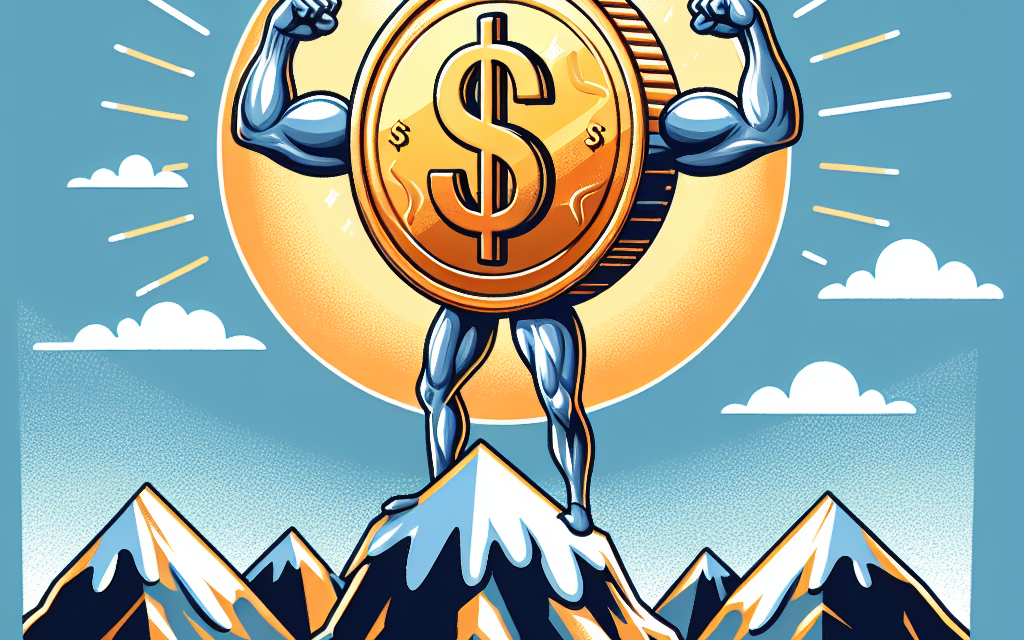“The US Dollar: Masterfully Valued and Ready to Rise.”
Introduction
The US Dollar, often regarded as the world’s primary reserve currency, has garnered significant attention in financial markets due to its remarkable strength and stability. Characterized by its resilience against global economic uncertainties, the dollar is frequently described as being “priced to perfection.” This phrase encapsulates the notion that the currency’s value reflects an optimal balance of economic indicators, geopolitical stability, and investor confidence. As the Federal Reserve navigates interest rate policies and inflationary pressures, the dollar’s position is further bolstered by robust economic data and a flight to safety during turbulent times. With ongoing global challenges and shifting dynamics, the US Dollar is not only maintaining its dominance but is also poised for further gains, making it a focal point for investors and analysts alike.
The US Dollar’s Resilience in a Volatile Market
In recent years, the US dollar has demonstrated remarkable resilience in a volatile market, a phenomenon that can be attributed to several interrelated factors. As global economic uncertainties continue to shape financial landscapes, the dollar has emerged as a safe haven for investors seeking stability. This status is not merely a reflection of the currency’s historical strength but also a testament to the underlying economic fundamentals that support its value. The interplay of these elements has led many analysts to describe the dollar as “priced to perfection,” suggesting that it is well-positioned for further gains in the foreseeable future.
One of the primary reasons for the dollar’s resilience is the relative strength of the US economy compared to its global counterparts. While many countries grapple with inflationary pressures, supply chain disruptions, and geopolitical tensions, the United States has managed to maintain a robust economic performance. This strength is underscored by consistent job growth, consumer spending, and a resilient manufacturing sector. As a result, the Federal Reserve’s monetary policy has been characterized by a cautious approach to interest rate adjustments, which has further bolstered investor confidence in the dollar.
Moreover, the dollar’s status as the world’s primary reserve currency plays a crucial role in its resilience. Central banks around the globe hold significant amounts of US dollars in their foreign exchange reserves, which not only supports the currency’s value but also enhances its liquidity in international markets. This widespread acceptance of the dollar facilitates trade and investment, creating a self-reinforcing cycle that underpins its strength. Consequently, when market volatility arises, investors often flock to the dollar, driving up its value as they seek refuge from riskier assets.
In addition to these economic fundamentals, geopolitical factors also contribute to the dollar’s stability. As tensions rise in various regions, including Europe and Asia, the dollar often benefits from a flight to safety. Investors tend to favor the dollar during times of uncertainty, as it is perceived as a more stable and reliable asset compared to other currencies. This dynamic has been particularly evident in recent months, as global events have prompted a reevaluation of risk exposure among investors, further solidifying the dollar’s position in the market.
Furthermore, the dollar’s performance is also influenced by the dynamics of global trade. As the US continues to engage in trade negotiations and establish economic partnerships, the demand for the dollar remains strong. The currency’s role in international transactions ensures that it retains its relevance in a rapidly changing global economy. This demand is further amplified by the increasing reliance on digital currencies and fintech solutions, which often still require conversion to traditional currencies like the dollar for broader acceptance.
As we look ahead, the outlook for the US dollar appears promising. With a solid economic foundation, a strong position in global reserves, and a favorable geopolitical landscape, the dollar is poised for further gains. While market fluctuations are inevitable, the underlying factors supporting the dollar’s strength suggest that it will continue to thrive in the face of uncertainty. In conclusion, the US dollar’s resilience in a volatile market is not merely a temporary phenomenon; it reflects a complex interplay of economic, geopolitical, and market dynamics that collectively position it for sustained strength in the years to come.
Factors Contributing to the Dollar’s Strength
The strength of the US dollar has become a focal point for economists and investors alike, as various factors converge to create an environment where the currency is often described as “priced to perfection.” This phrase encapsulates the idea that the dollar’s current valuation reflects an optimal balance of economic indicators, geopolitical stability, and monetary policy, all of which contribute to its robust performance in the global market. Understanding these factors is essential for grasping why the dollar is poised for further gains.
One of the primary contributors to the dollar’s strength is the resilience of the US economy. Despite facing challenges such as inflationary pressures and supply chain disruptions, the economy has demonstrated remarkable adaptability. Strong consumer spending, bolstered by a tight labor market and rising wages, has fueled economic growth. This resilience is further supported by robust corporate earnings, which have outperformed expectations in many sectors. As a result, investor confidence in the US economy remains high, leading to increased demand for the dollar as a safe-haven asset.
In addition to economic performance, the Federal Reserve’s monetary policy plays a crucial role in shaping the dollar’s value. The Fed’s commitment to controlling inflation through interest rate hikes has attracted foreign investment, as higher interest rates offer better returns on dollar-denominated assets. This influx of capital not only strengthens the dollar but also reinforces the perception of the US as a stable and attractive investment destination. Furthermore, the Fed’s transparency and forward guidance regarding its policy intentions have instilled a sense of predictability in the markets, further enhancing the dollar’s appeal.
Geopolitical factors also significantly influence the dollar’s strength. In an increasingly uncertain global landscape, characterized by geopolitical tensions and economic instability in various regions, the US dollar has emerged as a preferred reserve currency. Countries and investors often flock to the dollar during times of crisis, seeking refuge from volatility. This phenomenon is particularly evident in emerging markets, where local currencies may be subject to rapid depreciation. As a result, the dollar’s status as a global reserve currency not only supports its value but also positions it favorably against other currencies.
Moreover, the dollar benefits from its liquidity and widespread acceptance in international trade. As the primary currency for global transactions, the dollar is used in a vast array of trade agreements and financial contracts. This ubiquity ensures that demand for the dollar remains consistently high, further solidifying its position in the foreign exchange market. Additionally, the dollar’s role in commodity pricing, particularly in oil and gold markets, reinforces its importance in global finance, as fluctuations in these commodities can directly impact dollar valuation.
Lastly, the interplay of global economic dynamics cannot be overlooked. As other major economies, such as the Eurozone and Japan, grapple with their own economic challenges, the relative strength of the dollar becomes even more pronounced. Central banks in these regions have adopted more accommodative monetary policies, which can lead to currency depreciation. In contrast, the US’s tightening stance enhances the dollar’s attractiveness, creating a favorable environment for further appreciation.
In conclusion, the confluence of a resilient US economy, prudent monetary policy, geopolitical stability, and the dollar’s unique position in global finance collectively contribute to its strength. As these factors continue to evolve, the dollar remains well-positioned for further gains, reinforcing its status as a cornerstone of the international monetary system.
The Impact of Interest Rates on the US Dollar
The relationship between interest rates and the value of the US dollar is a fundamental aspect of global finance that warrants careful examination. As the Federal Reserve adjusts interest rates, the implications for the dollar’s strength become increasingly pronounced. When the Fed raises interest rates, it typically leads to higher yields on US government bonds, making them more attractive to foreign investors. This influx of capital not only bolsters demand for the dollar but also enhances its value in the foreign exchange market. Consequently, a stronger dollar can create a feedback loop, where increased investment inflows further elevate the currency’s status.
Moreover, the dynamics of interest rates extend beyond mere capital flows. They also influence inflation expectations, which play a crucial role in shaping investor sentiment. When interest rates are increased, it signals the Fed’s commitment to controlling inflation, thereby instilling confidence among investors. This confidence can lead to a stronger dollar as market participants anticipate a stable economic environment. Conversely, if the Fed were to lower interest rates, it could signal a more accommodative monetary policy aimed at stimulating growth, which might weaken the dollar as investors seek higher returns elsewhere.
In addition to domestic factors, global economic conditions also impact the dollar’s value in relation to interest rates. For instance, if other central banks around the world maintain lower interest rates while the Fed raises its rates, the differential becomes a compelling reason for investors to favor the dollar. This scenario often results in a stronger dollar as capital flows into the US economy, seeking the higher returns that come with increased interest rates. Thus, the interplay between US interest rates and those of other nations creates a complex landscape that can significantly influence the dollar’s trajectory.
Furthermore, the anticipation of future interest rate changes can also affect the dollar’s performance. Market participants closely monitor economic indicators such as employment figures, inflation rates, and GDP growth, as these metrics provide insights into the Fed’s potential policy direction. If investors believe that the Fed is likely to raise rates in the near future, they may preemptively buy dollars, driving up its value even before any official announcement is made. This phenomenon underscores the importance of market sentiment and expectations in determining the dollar’s strength.
As we consider the broader implications of interest rates on the US dollar, it is essential to recognize the role of geopolitical factors. Events such as trade negotiations, political stability, and international conflicts can influence investor perceptions and, consequently, the dollar’s value. For instance, during times of uncertainty, the dollar often serves as a safe-haven currency, attracting investors seeking stability. In such scenarios, even if interest rates remain unchanged, the dollar may appreciate due to heightened demand driven by geopolitical tensions.
In conclusion, the impact of interest rates on the US dollar is multifaceted, encompassing capital flows, inflation expectations, global economic conditions, and market sentiment. As the Federal Reserve navigates its monetary policy, the dollar’s strength is likely to reflect these intricate dynamics. With interest rates currently positioned to support further gains, the dollar appears ‘priced to perfection,’ poised for continued appreciation in the face of evolving economic landscapes. Understanding these relationships is crucial for investors and policymakers alike, as they navigate the complexities of a global economy increasingly influenced by the movements of the US dollar.
Global Economic Trends Favoring the Dollar
The US dollar has long been regarded as a cornerstone of the global financial system, and recent economic trends suggest that it is not only maintaining its strength but is also poised for further gains. Several factors contribute to this phenomenon, creating an environment where the dollar is increasingly viewed as “priced to perfection.” One of the primary drivers of this trend is the relative strength of the US economy compared to its global counterparts. As the United States continues to demonstrate robust economic growth, characterized by low unemployment rates and rising consumer confidence, investors are increasingly drawn to the dollar as a safe haven. This is particularly evident in times of geopolitical uncertainty, where the dollar often appreciates as investors seek stability.
Moreover, the Federal Reserve’s monetary policy plays a crucial role in shaping the dollar’s trajectory. In recent years, the Fed has adopted a more hawkish stance, signaling its commitment to controlling inflation through interest rate hikes. As interest rates rise, the dollar becomes more attractive to foreign investors seeking higher returns on their investments. This influx of capital not only strengthens the dollar but also reinforces the perception of the US economy as a reliable investment destination. Consequently, the dollar’s appreciation is further supported by the widening interest rate differentials between the US and other major economies, particularly in Europe and Japan, where monetary policies remain accommodative.
In addition to domestic factors, global economic trends are also favoring the dollar. The ongoing recovery from the COVID-19 pandemic has been uneven across different regions, with many emerging markets struggling to regain their footing. This disparity creates a flight to quality, where investors prefer the stability of the US dollar over more volatile currencies. Furthermore, as supply chain disruptions continue to affect global trade, the dollar’s role as the world’s primary reserve currency becomes even more pronounced. Countries around the world are increasingly holding dollars to facilitate international transactions, further bolstering its demand.
Another significant factor contributing to the dollar’s strength is the increasing use of digital currencies and the evolving landscape of global finance. While cryptocurrencies have gained popularity, they have not yet supplanted the dollar’s dominance. In fact, the rise of digital currencies has often highlighted the advantages of the dollar, particularly in terms of liquidity and stability. As central banks explore the potential of central bank digital currencies (CBDCs), the dollar’s established infrastructure and widespread acceptance position it favorably in this new financial paradigm.
Moreover, geopolitical tensions, particularly between the US and other major powers, have led to a reevaluation of currency risks. As nations navigate complex trade relationships and political alliances, the dollar’s status as a reserve currency provides a sense of security for investors. This dynamic is further amplified by the US’s military and economic influence, which reinforces the dollar’s position in global markets.
In conclusion, the confluence of a strong US economy, favorable monetary policy, global economic disparities, and the dollar’s entrenched status as a reserve currency creates a compelling case for its continued strength. As these trends unfold, the US dollar is not only “priced to perfection” but is also well-positioned for further gains in the evolving landscape of global finance. Investors and policymakers alike will be closely monitoring these developments, as the dollar’s trajectory will undoubtedly have far-reaching implications for the global economy.
The Role of Inflation in Dollar Valuation
The valuation of the US dollar is intricately linked to the dynamics of inflation, a factor that plays a pivotal role in shaping investor sentiment and economic policy. Inflation, defined as the rate at which the general level of prices for goods and services rises, erodes purchasing power and can significantly influence currency strength. In the context of the US dollar, understanding the relationship between inflation and its valuation is essential for grasping why the dollar is often described as “priced to perfection” and poised for further gains.
To begin with, inflation expectations are a critical component in determining the dollar’s value. When inflation is anticipated to rise, investors typically adjust their portfolios to hedge against the diminishing purchasing power of cash. This often leads to increased demand for assets denominated in dollars, as they are perceived as a safer store of value. Consequently, a rise in inflation expectations can bolster the dollar’s strength, as foreign investors seek to hold US assets, thereby increasing demand for the currency. This phenomenon is particularly evident in times of economic uncertainty, where the dollar often serves as a safe haven.
Moreover, the Federal Reserve’s monetary policy plays a significant role in the interplay between inflation and the dollar’s valuation. The central bank’s decisions regarding interest rates are heavily influenced by inflation metrics. When inflation rises above the Fed’s target, it typically responds by tightening monetary policy, which includes raising interest rates. Higher interest rates tend to attract foreign capital, as investors seek better returns on their investments. This influx of capital can lead to an appreciation of the dollar, reinforcing the notion that the currency is “priced to perfection.” As the Fed continues to navigate the delicate balance between fostering economic growth and controlling inflation, the dollar’s trajectory remains closely tied to these policy decisions.
In addition to domestic factors, global inflation trends also impact the dollar’s valuation. As other economies experience inflationary pressures, the relative strength of the dollar can fluctuate. For instance, if inflation in the Eurozone or emerging markets rises significantly, the dollar may strengthen as investors flock to the perceived stability of the US economy. This relative strength is further amplified by the dollar’s status as the world’s primary reserve currency, which means that it is in constant demand for international trade and investment. As such, fluctuations in global inflation can create opportunities for the dollar to gain further traction.
Furthermore, the current economic landscape, characterized by supply chain disruptions and geopolitical tensions, has contributed to inflationary pressures that are likely to persist. These factors not only affect domestic inflation rates but also shape global economic conditions. As inflation remains a concern, the dollar’s appeal as a safe haven is likely to endure, positioning it favorably for continued appreciation. Investors are increasingly aware that the dollar’s strength is not merely a reflection of domestic economic performance but is also influenced by a complex web of global economic interactions.
In conclusion, the role of inflation in dollar valuation is multifaceted and significant. As inflation expectations rise, the dollar often benefits from increased demand and higher interest rates, reinforcing its status as a strong currency. Additionally, global inflation trends and the Federal Reserve’s monetary policy decisions further shape the dollar’s trajectory. Given these dynamics, it is clear that the US dollar is not only “priced to perfection” but is also well-positioned for potential gains in the face of ongoing inflationary pressures.
Comparing the US Dollar to Other Major Currencies
The US dollar, often regarded as the world’s primary reserve currency, has consistently demonstrated its strength against other major currencies. This resilience can be attributed to a combination of factors, including the robust performance of the US economy, the Federal Reserve’s monetary policy, and the dollar’s status as a safe-haven asset. When comparing the US dollar to currencies such as the euro, the British pound, and the Japanese yen, it becomes evident that the dollar’s advantages are multifaceted and deeply rooted in economic fundamentals.
To begin with, the eurozone has faced significant challenges that have hindered the euro’s performance. Economic disparities among member states, coupled with political uncertainties, have created an environment of volatility. For instance, countries like Italy and Greece have struggled with high debt levels, which have raised concerns about the stability of the euro. In contrast, the US economy has shown resilience, characterized by steady growth, low unemployment rates, and a strong consumer base. This economic stability has bolstered confidence in the dollar, making it an attractive option for investors seeking security.
Furthermore, the Federal Reserve’s monetary policy plays a crucial role in the dollar’s strength. The Fed has adopted a cautious approach to interest rate adjustments, which has contributed to a favorable environment for the dollar. In comparison, the European Central Bank has maintained a more accommodative stance, with negative interest rates and quantitative easing measures aimed at stimulating growth. This divergence in monetary policy has led to a stronger dollar relative to the euro, as higher interest rates in the US attract foreign investment and drive demand for the dollar.
In addition to these economic factors, the geopolitical landscape also influences currency valuations. The US dollar is often viewed as a safe haven during times of global uncertainty. For example, during periods of geopolitical tension or economic downturns, investors tend to flock to the dollar, driving up its value. In contrast, currencies like the British pound and the Japanese yen have not always enjoyed the same level of confidence. The UK’s ongoing challenges related to Brexit have created uncertainty surrounding the pound, while Japan’s prolonged economic stagnation has limited the yen’s appeal. As a result, the dollar has emerged as a preferred choice for risk-averse investors.
Moreover, the dollar’s liquidity and widespread acceptance in international trade further enhance its position. The dollar is the dominant currency for global transactions, accounting for a significant portion of trade and finance. This ubiquity not only reinforces the dollar’s status but also creates a self-reinforcing cycle where demand for the dollar continues to grow. In contrast, other currencies, while important, do not possess the same level of global reach or influence.
In conclusion, the US dollar’s strength relative to other major currencies can be attributed to a combination of economic stability, favorable monetary policy, geopolitical factors, and its dominant role in global trade. As these dynamics continue to evolve, the dollar remains ‘priced to perfection,’ suggesting that it is well-positioned for further gains. Investors and analysts alike will be closely monitoring these factors, as they will undoubtedly shape the future trajectory of the dollar in the global currency landscape. Ultimately, the dollar’s resilience underscores its importance as a cornerstone of the international financial system, reinforcing its status as a reliable and robust currency.
Future Predictions for the US Dollar’s Performance
The US dollar has long been regarded as a cornerstone of the global financial system, and its future performance continues to attract significant attention from economists, investors, and policymakers alike. As we look ahead, several factors suggest that the dollar is not only ‘priced to perfection’ but also poised for further gains. To understand this outlook, it is essential to consider the interplay of economic indicators, geopolitical dynamics, and monetary policy.
Firstly, the strength of the US economy plays a pivotal role in bolstering the dollar’s value. Recent data indicates robust economic growth, characterized by low unemployment rates and rising consumer confidence. This resilience is further supported by a strong labor market, which has shown remarkable adaptability in the face of global challenges. As the Federal Reserve continues to implement policies aimed at sustaining this growth, the dollar is likely to benefit from increased demand as investors seek safe-haven assets during periods of uncertainty.
Moreover, the Federal Reserve’s monetary policy decisions will significantly influence the dollar’s trajectory. With inflationary pressures persisting, the Fed has signaled a commitment to maintaining a tight monetary stance. This approach not only reinforces the dollar’s appeal but also positions it favorably against other currencies. As interest rates rise, the yield on dollar-denominated assets becomes more attractive, drawing foreign investment and further strengthening the currency. Consequently, the dollar’s status as the world’s primary reserve currency is likely to remain unchallenged, as central banks continue to hold substantial dollar reserves.
In addition to domestic factors, global geopolitical dynamics are also crucial in shaping the dollar’s future performance. The ongoing tensions in various regions, including trade disputes and geopolitical conflicts, have led to increased volatility in international markets. In such an environment, the dollar often emerges as a preferred currency for transactions and reserves, as it is perceived as a stable and reliable store of value. This trend is expected to persist, particularly as emerging markets grapple with their own economic challenges, which may drive investors toward the relative safety of the dollar.
Furthermore, the dollar’s role in global trade cannot be overlooked. As the world’s primary currency for international transactions, fluctuations in the dollar’s value can have far-reaching implications for global trade dynamics. A stronger dollar can make US exports more expensive, potentially impacting trade balances. However, it can also enhance the purchasing power of American consumers, stimulating domestic demand for imported goods. This duality underscores the complexity of the dollar’s influence on the global economy and suggests that its future performance will be closely tied to international trade developments.
As we consider these various factors, it becomes evident that the US dollar is well-positioned for continued strength in the coming years. While challenges may arise, such as potential shifts in global economic power or changes in monetary policy, the fundamental attributes of the dollar—its liquidity, stability, and widespread acceptance—are likely to prevail. Investors and analysts will undoubtedly keep a close eye on economic indicators and geopolitical events, but the prevailing sentiment suggests that the dollar’s trajectory remains upward. In conclusion, the combination of a resilient US economy, prudent monetary policy, and the dollar’s entrenched position in global finance collectively support the notion that it is ‘priced to perfection’ and poised for further gains in the foreseeable future.
Q&A
1. **What does “priced to perfection” mean in the context of the US Dollar?**
It refers to the US Dollar being valued at a level that reflects optimal economic conditions, with expectations of continued strength in the economy, interest rates, and geopolitical stability.
2. **What factors contribute to the US Dollar’s strength?**
Key factors include robust economic growth, higher interest rates compared to other currencies, strong demand for US assets, and the Dollar’s status as the world’s primary reserve currency.
3. **How do interest rates affect the US Dollar’s value?**
Higher interest rates attract foreign investment, increasing demand for the Dollar as investors seek higher returns, which can lead to appreciation of the currency.
4. **What role does inflation play in the valuation of the US Dollar?**
Moderate inflation can be positive for the Dollar, as it may lead to higher interest rates; however, excessive inflation can erode purchasing power and negatively impact the currency’s value.
5. **How does geopolitical stability influence the US Dollar?**
The US Dollar tends to strengthen during times of global uncertainty, as it is viewed as a safe-haven asset, leading investors to flock to it during crises.
6. **What are the implications of a strong US Dollar for global trade?**
A strong Dollar can make US exports more expensive and imports cheaper, potentially leading to trade imbalances and affecting the competitiveness of US goods abroad.
7. **What are the potential risks to the US Dollar’s continued strength?**
Risks include changes in monetary policy, economic downturns, rising inflation, or significant geopolitical events that could undermine confidence in the US economy or its currency.
Conclusion
The US Dollar is considered ‘priced to perfection’ due to its strong performance driven by robust economic fundamentals, including low unemployment, rising interest rates, and a resilient consumer sector. Additionally, geopolitical uncertainties and global economic challenges have led investors to seek the safety of the dollar, further enhancing its value. As the Federal Reserve continues to adopt a hawkish stance on monetary policy, the dollar is likely to maintain its strength, positioning it for further gains in the near future.





